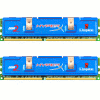- Qualcomm Launches Snapdragon 4 Gen 2 Mobile Platform
- AMD Launches Ryzen PRO 7000 Series Mobile & Desktop Platform
- Intel Launches Sleek Single-Slot Arc Pro A60 Workstation Graphics Card
- NVIDIA Announces Latest Ada Lovelace Additions: GeForce RTX 4060 Ti & RTX 4060
- Maxon Redshift With AMD Radeon GPU Rendering Support Now Available
Kingston 2GB PC2-6400 CL3

DDR3 might be lurking out there, but DDR2 is still the most popular option for most people, and for good reason. It’s fast, and currently, very inexpensive. Although there are many PC2-6400 kits available, Kingston puts a twist on their’s by offering it with tight 3-3-3 timings.
Page 2 – Overclocking, Testing Methodology, Sandra
Nowadays, it’s not uncommon to pick up a decent kit of DDR2 that won’t hit 600MHz, and this one was no exception. After all said and done, I had it running completely stable at 610MHz, with 2.50v. If you plan to replicate this setting, I highly recommend using a fan to keep your modules cool, as 2.4v+ is getting into dangerous territory.
Stock timings is 3-3-3-8, but move to 4-4-4 and you can drop a whopping 0.55v. While retaining those 4-4-4 settings, moving all the way up to 500MHz was possible, but with 2.20v. That’s still less than stock voltage however, so we will see in our graphs if that’s a better setting to use. Even 550MHz with 4-4-4 timings was possible, but it was using 2.60v, which I don’t recommend to anyone unless they have real good cooling.
- 400MHz 3-3-3-8 2.35v (2.40GHz CPU)
- 400MHz 4-4-4-8 1.80v
- 450MHz 4-4-4-8 2.10v (2.475GHz CPU)
- 500MHz 4-4-4-12 2.20v
- 500MHz 5-5-5-12 2.00v (2.40GHz CPU)
- 550MHz 4-4-4-12 2.60v
- 550MHz 5-5-5-15 2.20v
- 600MHz 5-5-5-15 2.50v
- 610MHz 5-5-5-15 2.50v (2.44GHz CPU)
Overall, I am pleased with the overclocking potential seen here. It didn’t blow me away, but this isn’t a high-performance kit, such as say, a PC2-9200. 600MHz proved stable, which is always the goal I try to hit with any kit that rolls into our labs.
Regardless of what performance-related part we are reviewing, there are a few conditions that we meet prior to benchmarking:
- Clean OS installation (Only required applications/games/benchmarks are installed)
- Desktop and scrap files are cleaned up, including emptying of recycle bin/trash.
- No virus scanner or firewall is installed in our stand-alone installations.
- Internet is disabled prior to any testing.
- Computer has proper airflow and room temperature is 80°F or less.
Below is all of the information regarding our testing machine. Links lead to our review of said product.
- Processor: Intel Core 2 Extreme QX6850 3.0GHz
- Motherboard: ASUS Blitz Formula
- Memory: Kingston 2GB PC2-6400 CL3
- Video: ASUS 8800GTX 768MB (NVIDIA 162.18)
- Sound: Onboard HD Audio
- Storage: Seagate 7200.10 320GB
- Power Supply: Corsair HX620W
- Etcetera: Windows XP Professional SP2, Antec P182
- Cooling: Corsair Nautilus 500
Sandra is always the first benchmark to come to mind when we need to do memory benchmarking. Or CPU benchmarking. Or storage benchmarking. You get the idea. It’s a superb all-around tool that we rely on quite often.

Stock settings were nice, but shooting up the CPU another 75MHz and increasing the frequency to DDR2-900 (while loosening the timings a bit) gave us quite a nice gain. Moving to 5-5-5 hurt though, except at 610MHz, not surprisingly.
|
|
Support our efforts! With ad revenue at an all-time low for written websites, we're relying more than ever on reader support to help us continue putting so much effort into this type of content. You can support us by becoming a Patron, or by using our Amazon shopping affiliate links listed through our articles. Thanks for your support!





